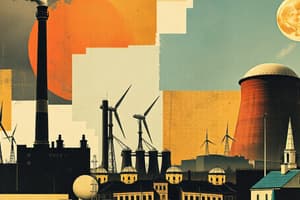Podcast
Questions and Answers
What is the Second Industrial Revolution?
What is the Second Industrial Revolution?
A process of technical innovations and economic transformations that began around 1870 and lasted until the outbreak of World War I in 1914.
Which of the following are key inventions of the Second Industrial Revolution? (Select all that apply)
Which of the following are key inventions of the Second Industrial Revolution? (Select all that apply)
- Telegraph (correct)
- Internal combustion engine (correct)
- Automobile (correct)
- Spinning Jenny
What caused the Second Industrial Revolution?
What caused the Second Industrial Revolution?
Technical innovations, increased production methods, and economic transformations.
The production method known as ______ was introduced during the Second Industrial Revolution.
The production method known as ______ was introduced during the Second Industrial Revolution.
Name one major characteristic of the Second Industrial Revolution.
Name one major characteristic of the Second Industrial Revolution.
The internal combustion engine was first developed in the early 20th century.
The internal combustion engine was first developed in the early 20th century.
Who is credited for patenting the telephone?
Who is credited for patenting the telephone?
What innovative means of transportation emerged from the Second Industrial Revolution?
What innovative means of transportation emerged from the Second Industrial Revolution?
What invention was led by the development of the radio?
What invention was led by the development of the radio?
What did Alfred Nobel patent in 1867?
What did Alfred Nobel patent in 1867?
Which of these was invented by Thomas Edison?
Which of these was invented by Thomas Edison?
Flashcards are hidden until you start studying
Study Notes
Second Industrial Revolution
- A period of technical innovations and economic transformations that began around 1870 and ended in 1914.
- Capitalism spread globally during this time.
Key Inventions
- Internal Combustion Engine: Developed by Nicolaus Otto in 1876.
- Automobile: The first car with an internal combustion engine was built by Karl Benz in 1886. Henry Ford's Model T was a key development in 1908.
- Airplane: While aviation had been experimented with for many years, it was the Wright brothers' sustained flight in 1903 that revolutionized air travel.
- Electric Tramway: Electric power did not replace steam for railroads but led to the development of electric tramways, the first of which opened in Berlin in 1881.
- Telegraph: Though invented earlier, its widespread use came in the second half of the 19th century thanks to Samuel Morse.
- Radio: Based on the discovery of electromagnetic waves by Heinrich Hertz in 1887, the radio was developed by Guillermo Marconi in the early 20th century.
- Telephone: Patented by Alexander Graham Bell in 1876, the telephone became commonplace in the 20th century.
- Dynamite and TNT: Swedish chemist Alfred Nobel patented dynamite in 1867, a safer explosive than nitroglycerin and more powerful than gunpowder.
- Phonograph: Developed in 1877 by Thomas Edison, it was the first device capable of recording and reproducing sound.
Key Characteristics of the Second Industrial Revolution
- Geographic Spread: Industrialization, which originated in Great Britain, spread to several countries, including Germany, the United States, and Japan.
- Mass Production: "Mass production" or "production line" was introduced, utilizing assembly lines and specialized labor to increase factory output.
- Transportation Development: Steel production for railway and ship construction, new fuels, and the invention of the automobile and airplane powered by internal combustion engines greatly impacted transportation.
- New Materials and Energy Sources: Innovations in chemistry and technology, including the use of petroleum and electricity, led to new materials and energy sources.
- Telecommunications: The invention of the telephone and radio, as well as the phonograph and cinematograph, significantly transformed telecommunications.
Studying That Suits You
Use AI to generate personalized quizzes and flashcards to suit your learning preferences.




